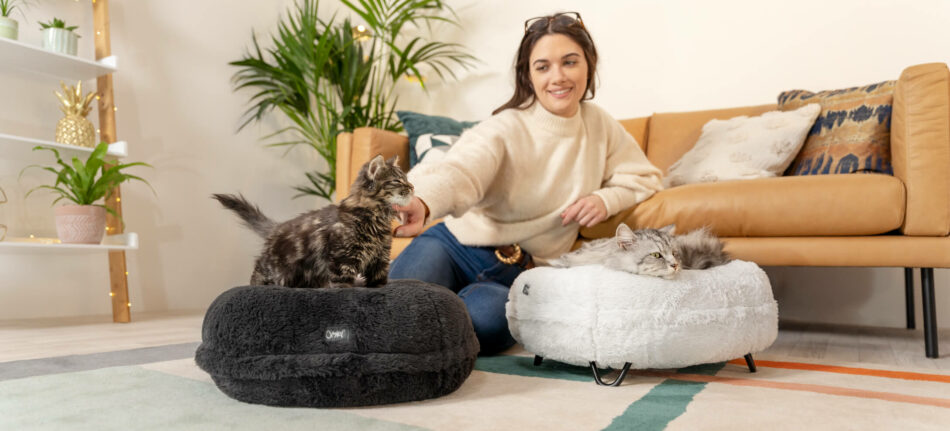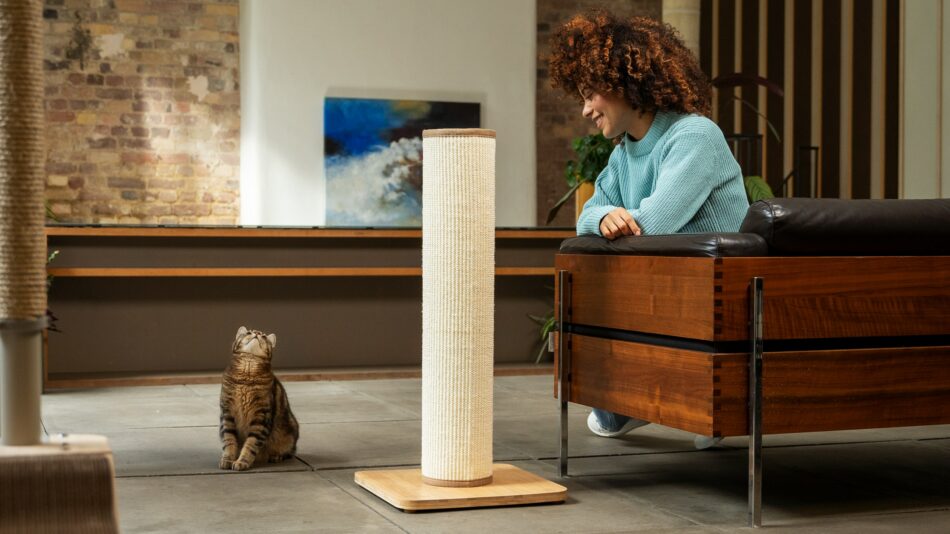What do cats love the most?
For centuries, felines have enchanted humans with their enigmatic nature. While often perceived as independent and aloof, beneath their cool exterior lies a rich tapestry of instincts and desires. But what do cats love the most? Understanding what truly caters to cats can deepen the bond between them and their humans. Explore the various facets of a feline’s affections with these insights into their natural behaviors and preferences, and how to best replicate them in your home.
Feline favorites
It’s tough to pinpoint one single “favorite” thing for every cat (they’re far too unique for that), but there are some common themes that come to light when observing their natural behaviors. Cats share a close genetic connection with their cousins – think big cats like lions, leopards, and cougars – so that even our domesticated, indoor cats have insatiable urges that closely mirror behaviors from their wild counterparts. You’ve probably seen your feline exhibiting some, if not all, of these favorite pastimes.
Hunting
Toys for cats aren’t just fun; they ignite their hunting drive and provide essential mental and physical stimulation. Cats, from the biggest to the smallest are natural predators. Your lounging feline can flip the switch from purring contentment to focused predator in mere seconds. That’s why cats are drawn to toys that mimic prey, like those that move and have feathers or fur. Laser pointers or cat toys with lights are also a favorite, as they demand a good chase.
Scratching
Scratching is an important cat behavior, and it serves multiple purposes:
- Sharpens their claws
- Stretches their muscles
- Marks their territory through scent glands in their paws
Sisal cat scratching posts are a favorite among felines because the material is durable, yet shreddable, which satisfies a cat’s natural urge to rake and tear. Providing a sturdy cat scratching post tall enough for your cat to fully extend and stretch is essential for curbing this craving – and for sparing your furniture.
Hide & sleep
Being predators, cats can feel vulnerable when they sleep. That’s why they often seek out secure, elevated, or enclosed spaces where they feel protected. This could be an indoor cat tree for them to climb or a supportive cat bed in a secluded place. These safe havens allow them to truly relax and feel like they’re in charge of their environment.
Routine
Cats are creatures of habit and thrive on predictability. Remember the time you rearranged the living room furniture and your cat held a grudge for a week? They still haven’t forgotten.
A consistent routine for feeding, playtime, and sleep can greatly reduce stress in your cat, and help them feel more secure. And their territory is also paramount; they’ll meticulously scent-mark their environment with their pheromones (that only they can smell) to establish boundaries and feel safe. It’s why cats are so offended by sudden changes to their surroundings, and any deviations to their normal should be introduced as gradually as possible.
Food
Food is another thing cats love. While a balanced diet is essential to their overall wellbeing, occasional treats can be a wonderful way to reinforce positive behavior and strengthen your bond. Consider cat-specific treats like small pieces of cooked chicken, salmon, or commercial cat treats designed for your cat’s lifestage or dietary needs. Use treats during training sessions with your cat, or hide some around their favorite areas of your home for a fun hunting game. Just remember to introduce new foods slowly and in moderation to avoid any digestive upset.
How to convey love to your cat
Beyond satisfying their basic needs, there are many ways to convey a deep sense of love and dedication to keeping your cat happy. You might just be rewarded with displays of affection from your cat in return.
Cater to your cat
As mentioned, consistency reigns supreme with cats. Aim to set a predictable schedule each day, starting with their meals. Consistent mealtimes not only help regulate their digestion, but build trust in your cat. Your cat will quickly learn that you are the provider of delicious provisions, which really reinforces a positive relationship. You may also find your feline snuggling up to you during your downtime. Cats will quickly catch on to your own schedule, so try to sync up with theirs by reading a book or watching a movie around the same time together each day.
Appeal to their nature
Unlike dogs, who crave constant attention, cats truly appreciate having their boundaries respected. Forcing interaction can lead to stress and a strained relationship. Always let your cat come to you on their terms, and make sure they have an opportunity to retreat to their safe space if they feel overwhelmed. Giving them control over their environment is key to their comfort.
Think outside of the box at playtime
Boxes and cats often go hand in hand. And while many cats can certainly have a grand time with a piece of cardboard, it’s beneficial to think outside of the box. Engaging in playtime with your cat is an excellent way to bond, and to ensure they’re getting ample mental and physical stimulation. Grab a wand or feather teaser toy, or crumple up some paper into balls to ignite their predatory instincts. These play sessions should mimic an actual hunt, so be sure to allow them to catch their “prey” at the end.
Cat communication
Cats communicate their affection in subtle but profound ways. Learning to interpret these signals will go a long way in understanding your feline friend. So if you’re wondering, “do cats love their owners?” look out for these signs:
- Head Nuzzles/Headbutts (Bunting): When a cat gently rubs their head or cheek against you, they’re depositing their scent glands, essentially marking you as part of their “colony” or family. This is a strong sign of trust and affection.
- Slow Blinks (“Cat Kisses”): If a cat makes eye contact and slowly blinks at you, try slowly blinking back. This is a sign of deep trust and affection, indicating they feel safe and comfortable in your presence. It’s their way of saying, “I trust you.”
- Purring: While purring can signify various emotions, a soft, consistent purr often indicates contentment and happiness, especially when they’re being petted or are curled up near you. It’s the sound of pure bliss.
- Kneading (“Making Biscuits”): This rhythmic pushing of their paws, often accompanied by purring, is a leftover behavior from kittenhood when they kneaded their mother to stimulate milk flow. In adult cats, it’s a sign of extreme comfort, contentment, and affection.
- Rubbing Against Legs: Similar to head bunting, rubbing against your legs is a way for cats to spread their scent and claim you as part of their territory. Congratulations: you’re officially theirs.
- Bringing “Gifts”: While sometimes unsettling (especially if it’s a real mouse), a cat bringing you a toy or even prey is a sign that they consider you part of their family and are sharing their “bounty” with you. It’s a macabre compliment, but a compliment nonetheless.
- Tail Position: A tail held high with a slight curl at the tip often indicates a happy, confident, and friendly cat. It’s like waving their own little flag of contentment.
Omlet and your cat
Every cat has a unique personality, blending their inherent instincts and individual experiences. But the fundamentals of feline happiness are consistent – which is why we’ve observed and interacted with cats extensively to create exactly what they crave. At Omlet, we know exactly what cats love the most. Our Cat Beds, Freestyle Cat Tree, and Switch Cat Scratcher have all been designed with feline instincts and preferences in mind to bring you and your cat closer than ever.
This entry was posted in Cats


